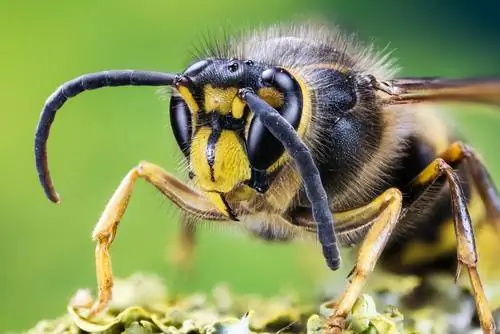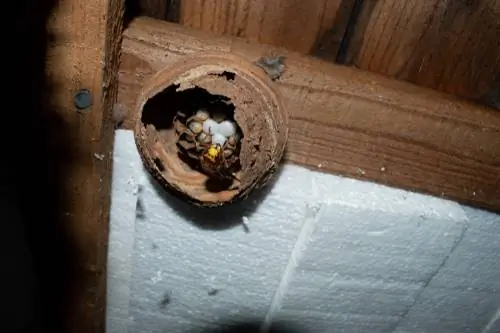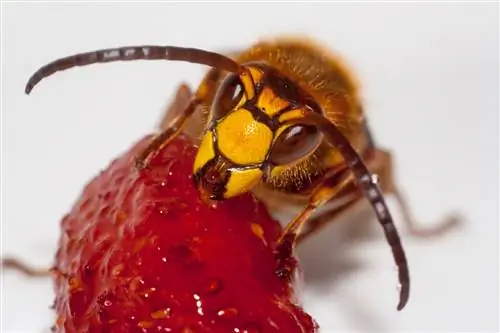- Author admin [email protected].
- Public 2023-12-16 16:46.
- Last modified 2025-06-01 06:02.
“Seven stitches kill a horse, three kill a person” - this old saying is still in many minds, but it is still wrong. Hornets - the largest wasp species living in our country - look dangerous, but are mostly harmless. The big hummers prefer to run away rather than mess with humans - unless they get too close to the hornet's nest.

Hornets are under nature protection
Many people are afraid of hornets and are therefore tempted to kill the animals and destroy their nests. However, both are strictly forbidden because the insects are protected. According to the regulations of both the Federal Species Protection Ordinance (BArtSchV) and the Federal Nature Conservation Act (BNatSchG), you are not allowed to catch or kill hornets, and their nests are not allowed to be touched.
Only upon request and for a legitimate reason (e.g. allergy sufferers and/or small children in the family, nest right next to the main entrance) may a specialist from the local environmental agency or fire department relocate the nest. If you do not adhere to these rules, you risk a high fine: Depending on the federal state, the willful destruction of a hornet's nest can cost you up to 50,000 euros and criminal proceedings in court.
In any case, unlike wasps, hornets are rather peaceful, so you can secure a possible nest with just a few measures, both for the animals and for you and your family. This also includes the correct rules of conduct.
Can you drive away hornets? The most important things in brief
- Catch hornets: Catching and injuring hornets is prohibited.
- Killing hornets: The targeted killing of hornets - even individual animals - is also prohibited.
- Removing a hornet's nest: Never remove and/or relocate a hornet's nest yourself. This can only be done by a qualified specialist upon request from the responsible authority. Costs: around 200 to 300 EUR, which you have to pay yourself.
- Remove hornets from the apartment: turn off the lights in the evening and open the windows wide
- Prevent hornets in the apartment: Install insect screens on doors and windows, close popular access holes in wooden cladding (e.g. on balconies and terraces), in wooden sheds and in roller shutter boxes
- Home remedies for defense: Hornets don't like the smell of lemons and cloves, which is why you can cut open lemons and sprinkle them with cloves and lay them out as a preventive measure. Alternatively, clove oil also helps.
Appearance
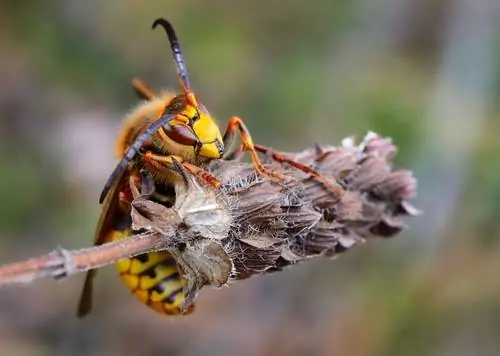
The hornet belongs to the real wasp family
Hornets are the largest genus of real wasps (Latin: Vespa) and so far only occur in one species in Germany: The hornet (Latin: Vespa crabro) was threatened with extinction until the 1970s and existed for a long time on the Red List of endangered species. However, the population has now recovered and hornets are now more common locally again. Hornets are significantly larger than their smaller relatives, the wasps, and also have characteristic reddish-brown and yellow stripes. However, the coloration can vary between individuals without it being a separate subspecies.
How big do hornets get?
The queen hornet reaches a length of up to 35 millimeters, but can only be seen outdoors until around June / early July. The significantly smaller workers reach a length of up to 25 millimeters.
Distinguishing between bees, wasps and hornets
The following table shows you how you can distinguish bees, wasps and hornets from one another based on their respective body lengths and coloring. Incidentally, contrary to a widespread misconception and numerous depictions in children's books, for example, bees do not have yellow and black stripes. In fact, this is a typical wasp coloration, which is why Maya the Bee is actually a wasp (and not a honey bee!).
| Honeybees | Common wasp | hornet | |
|---|---|---|---|
| Latin name | Apis mellifera | Vespula vulgaris | Vespa crabro |
| Genus | Honey bees (Apis) | Short-headed wasps (Vespula) | Hornets (Vespa) |
| Family | Real bees (Apidae) | Fold wasps (Vespidae) | Fold wasps (Vespidae) |
| Body length queen | 15 to 18 millimeters | up to 20 millimeters | 23 to 35 millimeters |
| Body length workers | 11 to 13 millimeters | 11 to 14 millimeters | 18 to 25 millimeters |
| Drone body length | 13 to 16 millimeters | 13 to 17 millimeters | 21 to 28 millimeters |
| Coloring | Basic color brown with striped abdomen | yellow-black stripes | reddish brown-yellow stripes |
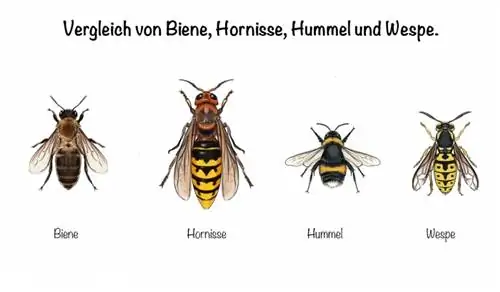
Possible confusion
Mimicry is widespread in nature as a protective mechanism, which is why not every red-brown striped and buzzing insect is actually a hornet. There are a whole range of insects that have adapted their appearance to the large predator and can therefore easily be confused with it. The reason for this is probably that these species are less at risk of falling victim to a predator (such as a real hornet).
These insect species look very similar to hornets:
- Medium wasp (Dolichovespula media): about the size of a hornet worker, but the dorsal plate is yellow-black and contains no reddish parts
- Hornet Hawkmoth (Sesia apiformis): butterfly common in Central Europe, whose adults reach a wingspan of between 30 and 45 centimeters, have transparent wings and are striped yellow and black
- Cimbicidae: various types of wasp-like hymenoptera that are between 15 and 28 millimeters long, marked in bright yellow, brown-red or black depending on the species
- Hornet hoverflies (Volucella zonaria): Species of fly from the hoverfly family, 16 to 22 millimeters long and clearly banded red-yellow-black
Background
Hornets are nocturnal
Unlike wasps and bees, hornets are nocturnal and fly to hunt even in the deepest darkness. This is also the reason why the animals are sometimes attracted to artificial light - like all nocturnal insects, they fly in the direction of light sources such as in living rooms or in the garden. Hornets can be easily driven away at night or not even attracted by simply turning off the light.
Lifestyle
Hornets are very social animals that live in a community consisting of around 300 to 700 animals. This consists of a queen, who begins building the nest and laying eggs in the spring, as well as the workers responsible for providing food, caring for the brood and later expanding the nest. The male drones, on the other hand, do not hatch until later in the year and are solely responsible for mating the young queens. The lifestyle and life cycle of hornets is very similar to that of bumblebees, although they are not hunters.
How old do hornets get?
Similar to bumblebees, hornets don't get particularly old: As adults, the workers have an average life expectancy of around 30 to 40 days, after development from egg to pupation, during which they go through five different stages lasts weeks. The drones also only reach an age of a few weeks and then die after mating. Only the queens can live up to a year, and they are the only ones to overwinter and leave their winter quarters and start building nests around April or May, depending on the weather. All other animals in the hornet state die by October at the latest. Towards the end of each season, the old queen produces up to 200 eggs, from which the young queens eventually hatch. Only these overwinter, while the old queen is gradually neglected by her workers and ultimately dies in the fall.
You don't have to fight hornets, you just have to be able to wait. In the fall the nest eventually empties itself.
Where do hornets hibernate?
The young queens and the drones finally fly out for mating in late summer/autumn. The male animals then die while the females look for a sheltered place to overwinter. To do this, they like to burrow into loose soil, but also use dead or rotten wood. The animals wake up from their hibernation around mid-April to the beginning of May and then start looking for a suitable nesting place.

Hornets overwinter in the ground or in rotten wood
How and where do hornets build their nest?
In the wild, hornets look for natural caves in the wood of rotten trees, but as cultural followers, the animals increasingly use substitute caves near human settlements. Here they also prefer wooden caves, which they can find, for example, in the cladding of walls, in wooden sheds, but also in nesting boxes and bat boxes. Cozy places such as roller blind boxes are also very popular. In addition, the animals sometimes build in very bizarre places, for example in old rubber boots left in the garden.
The queen starts building the nest in May and uses rotten wood, which she chews well. From this she builds the first cells, into which she immediately places eggs after completion and takes care of them. A queen creates around one or two such cells per day, so that the first workers usually hatch in June. Until then, the queen was solely responsible for building the nest, caring for the brood and providing the larvae with food, but the newly hatched workers now take on these tasks. From this point on, the queen is only responsible for laying eggs and takes care of herself.
Drones and young queens finally hatch between September and October. The old queen and the remaining workers then die, so that the nest is ultimately abandoned and empty in the fall. By the way, hornets don't use an old nest a second time, but they like to build a new one near it next year.
What do hornets eat?
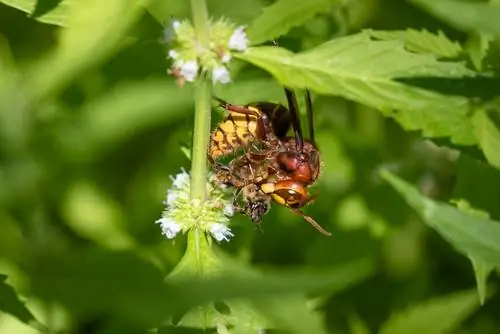
Hornets prefer to eat other, smaller insects
Hornets are insect hunters and do not feed on flower nectar like wasps or bees. Nevertheless, the large animals can often be found in the immediate vicinity of well-visited flowering plants as they wait for their prey here. A colony of hornets eats an average of half a kilogram of insects per day. The following species are most commonly hunted:
- Flies (Diptera) such as houseflies, flesh flies, blowflies and gold flies
- Brakes and calf sticks
- Wasps
- Honeybees
Around 90 percent of the prey consists of flies and horseflies, and wasps are also caught more often. For this reason, there are few wasps in gardens where there is a hornet's nest - the hornets keep the population here small and the sugar robbers away from your summer coffee table. Contrary to what many beekeepers believe, honey bees only catch hornets occasionally, so the damage to bee colonies remains minimal. Sometimes bumblebees are also among the hornets' prey, but only rarely.
The larvae mainly feed on the protein-rich food. Adult hornets, on the other hand, prefer tree and plant juices, which is why they can often be seen nibbling on trees (lilac, for example, is particularly popular) and fallen fruit.
Repel hornets
When the queen is looking for a nesting place in spring, she likes to get lost in apartments or the house. In this case, simply open two opposite windows so that the animals can find their way back outside through the draft. At night, hornets find their way out on their own as soon as they turn off the light sources - which usually attracted the animals in the first place - and open the windows wide. However, fly screens installed on doors and windows in a timely manner reliably keep hornets and other insects away.
This old home remedy also helps to keep the big buzzers out of the living rooms:
- Cut a fresh lemon into slices.
- Place the slices on a small plate.
- Speck them with some cloves.
- Place the plates directly in front of windows, doors and on the patio or balcony table.
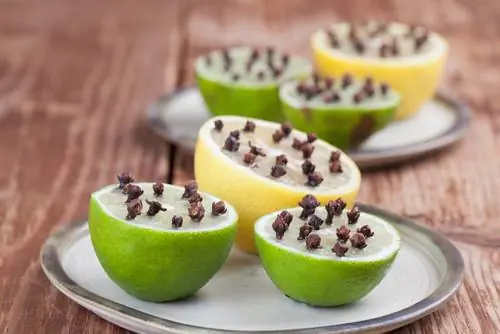
Lemon with cloves is said to keep hornets and other insects away
This tried and tested remedy not only reliably keeps hornets away, but also wasps. In order not to attract animals, you should also remove fallen fruit in the garden promptly and always cover sugary food and drinks outdoors.
How to deal with hornets correctly - avoid stings
Although hornets are considered less aggressive and are more likely to flee than sting, you should still take the following precautions near a nest:
- Keep a safety distance of at least two (preferably more) meters
- Avoid hectic and fast movements near hornets
- Avoid vibrations (e.g. from mowing the lawn)
- Do not blow on or breathe on hornets
- Do not hinder hornets in their flight path, especially not near the entrance hole
If you follow these rules, a peaceful coexistence between humans and hornets is possible - without any stings.
Remove hornet nest
However, this coexistence is not possible or only possible with difficulty if the hornet colony has chosen a very unfavorable place to build their nest. Therefore, in exceptional cases, removal and relocation is possible, although you are not allowed to carry out this measure yourself! Anyone who removes a hornet's nest themselves and without permission can be fined up to EUR 50,000, depending on the federal state.
If a hornet's nest needs to be removed, it is best to proceed as follows:
- Submit an application to the environmental agency or nature conservation authority in your district or city.
- The applications are often available on the Internet and can be downloaded and printed out there.
- After submitting the application, a specialist will come to your home to check the actual risk posed by the hornet's nest.
- If this is the case, the application will be approved and the nest can be removed by an exterminator, a fire department specialist or a beekeeper.
The costs of around EUR 100 to EUR 300 must be borne by you as the applicant. If the application is not approved, you can secure it yourself with the help of screens or fly wire and thus reduce any possible danger. However, you can remove hornet nests that are abandoned in the fall yourself; they will not be moved in again the following year anyway.
The following article shows how relocating a hornet's nest is done:

Preventing hornets
To prevent the animals from settling in the spring, you should close possible loopholes such as cladding, false ceilings and roller shutter boxes. Instead, you can offer the insects - which are after all very useful to nature - a special hornet box in a quiet, secluded part of the garden.
Excursus
Can you smoke hornets?
Since hornets are protected, you are not allowed to smoke them. If you are caught doing this or are told off by a neighbor, you can be charged in court and punished with a fine of up to EUR 50,000. Spraying with insect spray or vinegar is also not permitted.
Can hornets sting?
According to an old folk wisdom, hornet stings are considered particularly poisonous, so that life is said to be threatened after just a few stings. This assumption is wrong, because hornet venom is no more dangerous than wasp or bee venom - especially since a bee releases significantly more poison in a single sting than a hornet. A hornet sting is therefore no more dangerous than any other insect sting. In terms of pain, such a sting is often described as more painful than that of a wasp or bee. However, this may be subjective, as the larger insect is also perceived as more threatening. In fact, hornets are quite peace-loving and not very aggressive animals and only sting if you get too close to their nest or corner them.
How often can hornets sting?

The stinger of hornets has no barb
Since hornets, unlike bees, do not have a barb on their stinger, it does not get stuck in the skin. This means that a hornet can basically sting multiple times because they then continue to live and do not die. To prevent this from happening in the first place, always keep a safe distance, especially from the nest, and do not make any hectic movements near a hornet. Don't even think of catching the animal with your hand or reaching for it.
What to do after a hornet sting?
Unless you have been stung in the mouth or throat or are allergic to wasp or hornet venom, it is not necessary to see a doctor. The swelling goes away after a few days and can be easily treated with a cooling gel from the pharmacy. However, no further measures are necessary.
Excursus
Allergic reaction after a hornet sting - act correctly
It only becomes dangerous if you are allergic to the hornet venom, which is rare and affects an estimated two to four percent of the population. However, people with a wasp venom allergy often also react to hornet venom because the composition of both substances is very similar. Those who are allergic to bee venom, on the other hand, can breathe a sigh of relief: Since the venom of honey bees is chemically different from that of wasps and hornets, cross allergies are not to be feared here.
Typical symptoms of an allergic reaction are:
- Circulation problems immediately or shortly after the sting
- unusually severe swelling and rashes
- these can also be away from the injection site
- Shortness of breath and dizziness indicate an allergic shock
If you have allergic symptoms, you should consult a doctor who will treat you with anti-allergics - usually preparations containing cortisone. The symptoms should then improve quickly. Only if there are signs of an allergic shock (circulatory problems up to and including fainting, shortness of breath) should the emergency doctor be called immediately, as there is an acute danger to life.
Frequently asked questions
Do hornets, like wasps, also like sweets?
Hornets primarily hunt other insects, but they like sweet plant and tree juices. However, the animals rarely eat sugary human food and when they do, it is usually to hunt the wasps that are there. However, they find fallen fruit very tempting, which is why you always have to be careful when picking up apples and pears that have fallen on the ground - there could be hornets in them.
What are hornets good for?
The large hunters are very useful animals in the garden as they hunt many pests and nuisances - especially flies. In addition, the wasp population is often low in regions with many hornets.
Do hornets have natural enemies?
The caterpillars of the bumblebee nest moth (Aphomia sociella) are brood predators and feed on the clutches and larvae of the hornets. The caterpillars of the butterfly from the borer family are active between August and April and, like the hornet queen, they hibernate.
What can you do about hornet droppings?
Hornets make a lot of “dirt”, which usually accumulates under the nest and can cause damage. To prevent this, you can place a bucket or other container under the hornet's nest and collect the animals' droppings.
Are there other species of hornets?
The Asian hornet (lat. Vespa velutina) has been spreading in Europe for several years. This species, originally native to East Asia, was probably brought here with imported goods and finds ideal living conditions thanks to the increasingly mild winters. The queens of the species can be up to three centimeters long and are therefore smaller than the native hornet species. However, the Asian giant hornet (Vespa mandarinia), which is up to six centimeters long, has not yet been reliably detected in Europe. The Oriental Hornet (Vespa orientalis) is mainly found in southern Europe.
Why do hornets throw out their larvae?
When hornets throw their larvae out of the nest, these are dead or non-viable larvae. This is particularly noticeable in autumn, when they can no longer pupate in time anyway.
Tip
Clove oil is also a great defense against hornets. To do this, you can put a few drops of the essential oil in an aroma lamp and place it on the table outside or in the apartment. The product also has a pleasant side effect and also keeps hungry wasps away.

